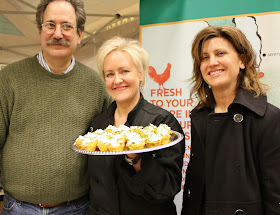I learn by doing. I read obsessively about topics, experiment, and read some more. And then I consult the experts. By that point, I've read and experienced enough to have a meaningful conversation.
My ice cream obsession led to...a professional machine with built-in compressor (to churn batch after batch -- no freezing the bowl between batches) and 100+ tried & true recipes. When my obsession hit a fever pitch, I consulted with food scientist Shirley Corriher and Alice Medrich on the role of starch in ice cream.
It's like that.
For years, I've been a bread baker voyeur. I've taken classes with experts in the field, traveled to famous bakeries all over the world, toured wheat farms, read textbooks and countless books on baking, and have staged alongside the captain of the world champion baking team.
But I never made my own bread.
I just watched, and read.
A lot.
Last week, I took the plunge and made my first yeasted loaf. Inspired by this hauntingly delicious challah, I attempted my own. The results were passable but nothing like the challah she made. It lacked the depth of flavor that is the hallmark of a slow rise.
I tried again, armed with an intriguing recipe by James Beard. Instead of mixing the water, yeast and a bit of sugar and waiting for the yeast to work its magic, Beard's recipe jumps right in and adds it all together...liquid, yeast and flour. The addition of eggs and milk enrich the flavor substantially, and sesame seeds scattered across the top, toast beautifully.
Already my mind was spinning with possibilities. What if I replaced the water with something more flavorful, like onion stock? What if I chilled the dough between risings? This recipe calls for only two risings, but I have another recipe that calls for four. How would that change the final outcome?
You see? The genie is out of the bottle, and my bread obsession is in full swing. If you find a loaf of bread on your doorstep, that's me...parsing out experiments.
***

 Many thanks to Charlie for sharing this recipe. As he notes, if you're new to baking, it's a great bread for beginners.
Many thanks to Charlie for sharing this recipe. As he notes, if you're new to baking, it's a great bread for beginners.Recipe By: James Beard, Beard On Bread
Ingredients:
5 cups all-purpose flour, or unbleached hard-wheat
1/4 cup granulated sugar
2 teaspoons salt
1 package active dry yeast
1 1/2 cups milk
1/2 stick butter, cut into 1-inch cubes
2 eggs
1 egg white, lightly beaten with 1 tablespoon of water
sesame seeds
Directions:
In a large mixing bowl combine 1 Cup of the flour, the sugar, salt, and dry yeast.
Heat the milk and the butter in a saucepan, just until the milk is warm; the butter does not need to melt.
Add the eggs and the warm milk mixture to the flour mixture. (This, as you will notice, is one of those newish dry-mix processes where you do not proof the yeast first-and it works.)
Mix very well until thoroughly moistened, and beat with a wooden spoon for about 5 min. Then stir in the remaining flour to form a stiff dough.
Turn out on a floured board, and knead the dough until it is quite smooth and elastic, about 5 min. Work into a ball, place in a buttered bowl, and turn to coat with butter on all sides. Cover and let rise in a warm, draft-free place until light and doubled in bulk, 1 to 1 1/2 hrs.
Punch the dough down and divide into six equal portions. Roll each of these portions into a thin cylinder about 8 to 10 in. long. Take three strips and braid them together. Place the braid on a baking sheet buttered or sprinkled with cornmeal. Braid the remaining three strips and place about 6 in. away from the other loaf. (For a more spectacular loaf, make a braid of three large strips and then a braid of three smaller strips, and put one on top of the other. This takes a good hr. to bake and a slight amount of dexterity to shape.)
Cover the loaves and let rise in a warm, draft-free space until doubled in bulk, which will take another 1 1/2 hrs.
Brush with the egg white and water, sprinkle lavishly with sesame seeds, and bake in a preheated 375 deg. oven for 35 to 40 min. or till golden brown.

 Tessa's Chickpea, Feta and Cilantro Salad makes frequent appearances both at home and for social occasions. It travels well, is easily doubled, and if there are dietary restrictions in the crowd? I've got it covered. Vegetarian? Yep. Gluten-free? Check!
Tessa's Chickpea, Feta and Cilantro Salad makes frequent appearances both at home and for social occasions. It travels well, is easily doubled, and if there are dietary restrictions in the crowd? I've got it covered. Vegetarian? Yep. Gluten-free? Check! 




 Not only did I rave about sous chef John Jadamec's dish, there was some shameless recipe begging going on here!
Not only did I rave about sous chef John Jadamec's dish, there was some shameless recipe begging going on here!




























































